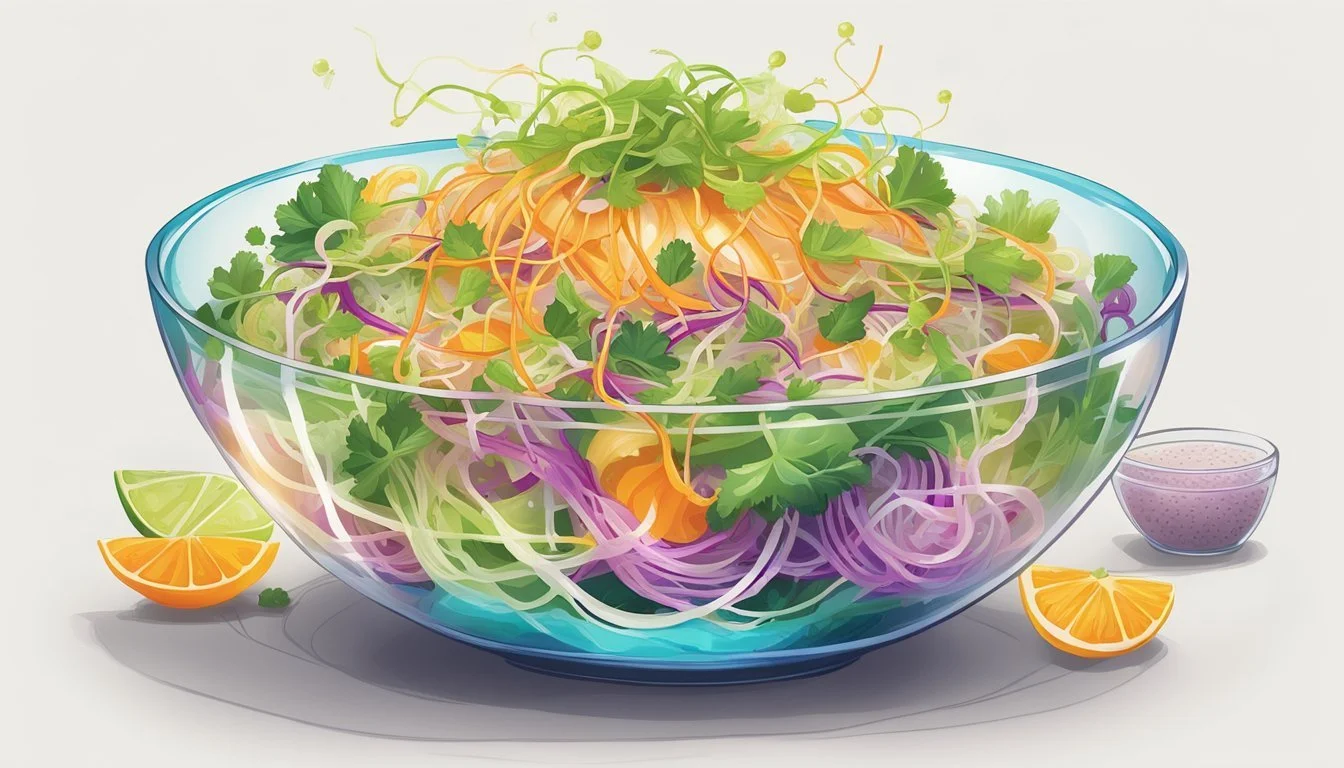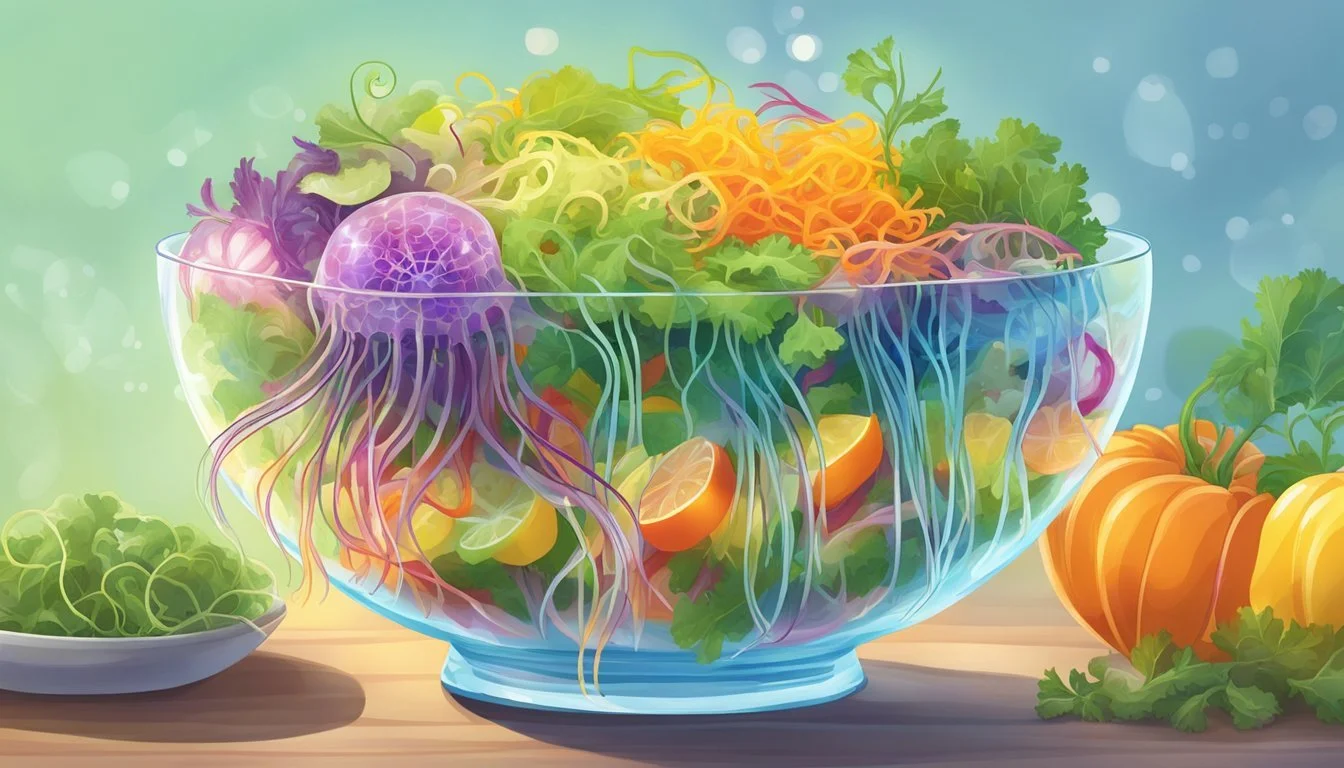Jellyfish Salad
Discover Asia's Refreshing Crunchy Delicacy
Jellyfish salad is a dish that's gaining popularity outside its traditional Asian roots, appealing to adventurous eaters and health-conscious foodies alike. Known for its unique, crunchy texture and refreshing quality, it offers a distinctive dining experience. This culinary specialty is often made from salt-cured jellyfish, which after a thorough rinsing and perhaps a soak in hot water, takes on a pleasingly crisp consistency.
In preparing jellyfish salad, the protein-rich jellyfish is typically complemented with a variety of vegetables like cucumbers and carrots, adding freshness and color to the dish. Seasonings such as lemon juice, rice vinegar, and sesame seeds can be tossed in to add a burst of flavor, marrying well with the subtle taste of the jellyfish. As a cold dish, it can be particularly enjoyable in warm weather, serving as a palate-cleansing starter or a light main course.
The health benefits of jellyfish, which is low in calories and contains beneficial minerals like selenium, often make it an attractive option for those looking to include more healthy proteins in their diet. Its preparation can vary from simple toss-and-serve recipes to more elaborate presentations involving intricate seasonings and marinades. Regardless of how it's prepared, jellyfish salad remains a conversation-starting dish that's as healthy as it is refreshingly different.
Origins and Popularity
Jellyfish Salad is a traditional dish that finds its origins in various Asian cuisines, particularly within Chinese and Korean gastronomy. Known for its distinct crunch and refreshing quality, it often features on menus as Haepari-naengchae in Korea, a testament to its popularity and integration into the culture.
In Chinese cuisine, the dish is a staple at festive occasions, relished for its texture and unique flavor profile. Its preparation and consumption stretch back centuries, with its refreshing nature making it especially popular in the warmer months.
Korean Jellyfish Salad has secured a loyal following both domestically and internationally. This dish showcases a blend of thinly sliced vegetables and well-seasoned jellyfish, demonstrating Korea’s innovative use of diverse ingredients. Asian grocery stores play a crucial role in its dispersion, offering specially prepared jellyfish ready for use in home kitchens around the globe.
The popularity of Jellyfish Salad has grown beyond its Asian roots, captivating the palates of adventurous diners the world over. It's seen as both a delicacy and a common appetizer, with its appeal lying in the combination of slippery texture and a dressing rich in sesame oil, soy sauce, and various spices.
Ingredients typically used in Jellyfish Salad:
Jellyfish: Often sold ready-to-eat in Asian grocery stores.
Vegetables: Cucumbers, carrots, and flavors from green onions and garlic.
Dressing: A mix of sesame oil, soy sauce, vinegar, and occasionally chili oil for heat.
Asia's gastronomic scene has effectively shared this novel dish through restaurants and cultural exchange, solidifying its status as a refreshing bite that intrigues with every crunch.
Nutritional Profile
Jellyfish salad, a crunchy and refreshing dish, offers a distinct nutritional composition. Its profile includes essential macronutrients and a range of health benefits making it a worthy addition to a balanced diet.
Protein and Fiber Content
Jellyfish is notable for its protein content, which is important for muscle repair and growth. However, it provides minimal dietary fiber, which is typically sourced from additional ingredients in the salad such as vegetables.
Caloric and Macronutrient Information
Calories: 36 kcal
Carbohydrates: 0 g
Protein: 5.6 g
Fat: Traces
Sodium: High; varies by preparation
The calories in jellyfish are low, making it a low-energy-dense food. The macronutrient profile is predominantly protein, with negligible fat and carbohydrates.
Health Benefits
Although jellyfish itself is not abundant in fiber, vitamins, or minerals, it can contribute to a healthy diet when paired with vitamin-rich vegetables and fiber-packed ingredients. Its high protein content supports body tissues, and the low-calorie count makes it a weight-friendly choice.
Dietary Considerations
Jellyfish salad often contains high sodium levels due to the processing of the jellyfish and added seasonings. Thus, individuals monitoring their sodium intake should consume it in moderation. Additionally, the protein in jellyfish is beneficial, but it should be part of a diversified diet that includes other protein sources with a complete amino acid profile.
Key Ingredients
Preparing a jellyfish salad requires a combination of specific ingredients that contribute to its unique taste and texture. Each component plays an integral role in creating the authentic experience of this Asian dish.
Jellyfish: The Main Component
The star of this dish is salted jellyfish, which is known for its chewy texture and subtle flavor. It is typically prepared by washing and soaking to remove excess salt and then blanched to achieve the desired tenderness.
Vegetable Additions
A variety of vegetables are commonly included to add crunch and freshness to the dish. Traditional options feature:
Thinly sliced English cucumber
Julienned carrots
Sliced daikon radish
Strips of red bell pepper Adding Asian or Korean pear can introduce a hint of sweetness to the crisp texture profile.
Flavor Enhancers
To balance the flavors and elevate the salad, a blend of seasonings and dressings is used:
Vinegar (often rice wine vinegar) for tanginess
Soy sauce for umami
Sesame oil for nuttiness
Minced garlic and ginger for aromatic spice
Chili oil or Korean mustard for heat
A sprinkle of sesame seeds and chopped scallions garnishes the dish and adds another layer of flavor.
Ingredient Alternatives
Individuals can experiment with the ingredients to match their preferences or dietary needs. For those who don't eat meat, shredded chicken can be omitted or replaced with tofu. Cucumbers can be exchanged for other crunchy vegetables like celery.
Where to Buy
Ingredients such as salted jellyfish can be sourced from an Asian grocery store. It's important to seek quality produce like crisp English cucumbers and fresh Asian pears, alongside other essential ingredients, to ensure the salad is as authentic and flavorful as possible.
Preparing the Jellyfish Salad
Creating a delectable Jellyfish Salad involves two crucial steps: preparing the salted jellyfish to achieve the right texture and combining them with finely cut vegetables for a refreshing crunch.
Preparing the Jellyfish
To ensure the jellyfish is ready for your salad, begin by thoroughly washing the jellyfish strips in cold water to remove excess salt. It is important to then soak the jellyfish in hot water, typically around 160°F (70°C), for a duration that allows it to soften without losing its characteristic crunch—about an hour is sufficient. Once the jellyfish is adequately tender, it should be drained and cut into thin strips. The point here is to achieve a texture that will complement the crispness of the fresh vegetables.
Cutting and Mixing the Vegetables
The vegetables—cucumbers, carrots, daikon radish, and a red bell pepper—should be julienned, or cut into thin strips, to match the jellyfish in both the size and shape. This ensures uniformity in every bite and makes the salad visually appealing. For cucumbers, it's recommended to:
Peel and halve lengthwise.
Sprinkle with salt and leave for 10 minutes to draw out excess water.
Rinse and dry to ensure they don't dilute the flavors of the dressing.
Carrots and daikon radish should also be peeled and shredded, while the bell pepper should be seeded and cut into similarly fine shreds. Combine the jellyfish strips and the mix of vegetables in a large bowl. The key is to toss them lightly to maintain the integrity of each component and ensure an even distribution of flavors.
The Dressing: A Blend of Flavors
The dressing for jellyfish salad is crucial in unifying the distinct flavors of the dish. It enhances the jellyfish's subtle taste and adds a refreshing zing with its combination of sweet, sour, spicy, and salty components.
Creating the Perfect Balance
To achieve a harmonious blend in the dressing, the central elements must be finely tuned. A typical dressing includes:
Sweetness: Often provided by sugar, it counterbalances the sharper tastes.
Saltiness: Salt or soy sauce can be used to intensify the umami character.
Sesame Oil: Adds a nutty and rich layer to the overall profile.
Heat: Ginger or chili oil may be included for a warm, spicy note.
A skilled chef knows that the key to perfection lies in adjusting these ingredients to complement each other without one overpowering the rest.
The Role of Acidity
Acidity plays a pivotal role, cutting through the richness and bringing brightness to the dish. Rice vinegar is the most common choice, delivering a milder acid compared to regular vinegar. Its subtle tartness lifts the complex flavors, providing a palate-cleansing effect. The use of rice wine vinegar can also contribute to this sour dimension while introducing a hint of sweetness that augments the sugar's profile. The careful calibration of acidity ensures that each bite of the jellyfish salad is as refreshing as the last.
Serving Suggestions
Jellyfish salad is a dish known for its refreshing qualities, making it an excellent choice for those seeking a light yet flavorful addition to their meal. Its unique texture and cooling sensation provide an enjoyable eating experience, especially in warmer climates or seasons.
As a Refreshing Side Dish
Jellyfish salad serves well as a cold dish alongside a variety of main courses. Ideal for summertime dining or as a palate cleanser between heavier meals, it brings a burst of freshness to the table. For enhanced taste, it's often garnished with light soy sauce and sprinkled with finely chopped green onions to complement its subtle flavor.
Ingredients for garnish:
Light soy sauce
Green onions, finely chopped
Sesame seeds (optional)
This dish's crispness can balance out the richness of fried or grilled meats, providing a contrasting yet harmonious dining experience.
Pairing with Other Foods
As a side dish, jellyfish salad pairs beautifully with other Asian cuisine staples, serving as a fitting snack or complement to main courses. Its delicate taste does not overpower other flavors, making it versatile for various combinations.
Ideal Pairing Options:
Grilled seafood or poultry
Steamed rice or noodles
Dim sum
Incorporate jellyfish salad into a multi-course meal for added texture and a refreshing touch that can lighten the palate before moving on to the next flavorful dish.
Storage and Food Safety
When creating jellyfish salad, maintaining proper refrigeration and observing handling precautions are crucial for ensuring the dish's safety and freshness due to its delicate nature as a cold dish.
Refrigeration and Shelf Life
Jellyfish salad should be stored in a refrigerator at a temperature between 35°F and 40°F. The shelf life of refrigerated jellyfish salad can typically range from 1 to 3 days. If the salad contains additional perishable items like cooked chicken or vegetables, the dish should be consumed earlier to ensure freshness and safety. Salted jellyfish, commonly used in the salad, must be desalted and consumed promptly after preparation to prevent spoilage.
Immediately after preparation: Place in refrigerator.
Maximum storage time: 1-3 days for optimal freshness.
Handling Precautions
As with all seafood dishes, (What wine goes well with seafood dishes?) one must take extra precautions when handling jellyfish to prevent food-borne illness. Jellyfish are often sold in a salted state for preservation and must be thoroughly rinsed before use. Hands should be washed with soap and water before and after handling the jellyfish. Cross-contamination with raw foods should be avoided, and utensils and cutting surfaces must be sanitized.
Before use: Rinse salted jellyfish thoroughly.
Preparation hygiene: Wash hands, utensils, and surfaces.
By following these guidelines, one can ensure that jellyfish salad remains a safe and enjoyable treat.
Cultural Significance
Jellyfish salad, known as haepari-naengchae in Korean, is more than just a dish; it represents a tradition steeped in the culinary tapestry of Asian cuisine. This delicacy is particularly celebrated in Korea, where it is often served during special occasions and deemed a luxurious treat.
In Korea, the salad is noted for its refreshing and light qualities, making it especially popular during the warmer months. It is not uncommon to find haepari-naengchae gracing the tables at weddings and festive gatherings, symbolizing a wish for prosperity and good fortune. The textural contrast of crunchy jellyfish against other ingredients embodies the Korean culinary philosophy of harmony and balance on the palate.
Korean Context: Haepari-naengchae, Meaning: Korean jellyfish salad
Special Occasions: Symbolizing prosperity and good health
Culinary Harmony: Balance of textures and flavors
The salad is also reflective of the coastal heritage of many Asian countries, highlighting the significance of the sea in regional diets. Sustainability and utilizing all parts of sea creatures is a deeply embedded practice that further enrichs the cultural fabric.
Jellyfish salad's preparation and enjoyment are imbued with respect for taste, texture, and the bountiful gifts of the ocean, seamlessly intertwining with the cultural narrative of the Korean people and wider Asian communities.
Enhancing Your Culinary Skills
To master Jellyfish Salad—a refreshing and crunchy Asian dish—one must focus on embracing creativity with ingredients and refining the necessary preparation techniques.
Experimentation and Variation
Chefs often experiment with Jellyfish Salad, developing their own recipes that reflect a balance of textures and flavors. It's encouraged to:
Start with the basic components like pre-treated jellyfish, cucumber, and carrots.
Introduce different dressings, such as a mixture of sesame oil, soy sauce, and vinegar—each bringing a unique flavor profile.
By altering ingredients, one can transform this dish from its traditional form into something new, keeping the preparation quick and easy yet innovative. It's essential to taste and adjust seasonings as needed, ensuring each variation of the recipe maintains harmony among the ingredients.
Mastering the Techniques
The key to a superlative Jellyfish Salad lies in the mastery of preparation techniques. Essential steps include:
Properly cleaning the jellyfish: It should be washed and then soaked in water to remove excess salt.
Slicing ingredients thinly: This ensures a delicate, pleasant texture.
Technique: Soaking Jellyfish, Description: Soak in warm water to remove salt, often for hours.
Technique: Straining and Drying, Description: After soaking, jellyfish must be thoroughly dried.
Technique: Seasoning Just Right, Description: A balance of salt, sweet, and acid is crucial.
One should be diligent in learning how varying temperatures and cutting techniques can affect the final dish, aiming to deliver a recipe that is both quick and easy to prepare and delightful in texture.
Conclusion
Jellyfish Salad truly offers an exceptional culinary experience with its unique texture and taste. Renowned in several Asian cuisines, the salad is characterized by its crunchy jellyfish strips complemented by a medley of other ingredients, from crisp vegetables to aromatic herbs and flavorful dressings.
Nutritional Benefits: They may consider this dish not only for its taste but also for the potential health benefits of jellyfish, which is low in calories while rich in protein and collagen.
Culinary Versatility: Chefs appreciate the salad's adaptability; it can be tailored with a variety of dressings, ranging from zesty lemon juice and rice vinegar to spicy chili oils and fragrant sesame, allowing for personalized flavors to suit any palate.
Recipe Tips:
Ensure the jellyfish is properly prepared, rinsed, and desalted before marinating or dressing it.
Balance the flavors by considering the right mix of sweetness, acidity, and umami from ingredients like sugar, vinegar, and soy sauce, respectively.
Chill the salad before serving to enhance its refreshing quality, ideal for warm climates or as a palate-cleanser.
Whether served as a starter, side dish, or a light main course, Jellyfish Salad remains an intriguing option for those seeking to expand their culinary horizons. Its simplicity in preparation belies the complexity of flavors it brings to the table, a testament to the vast and creative world of Asian gastronomy.







